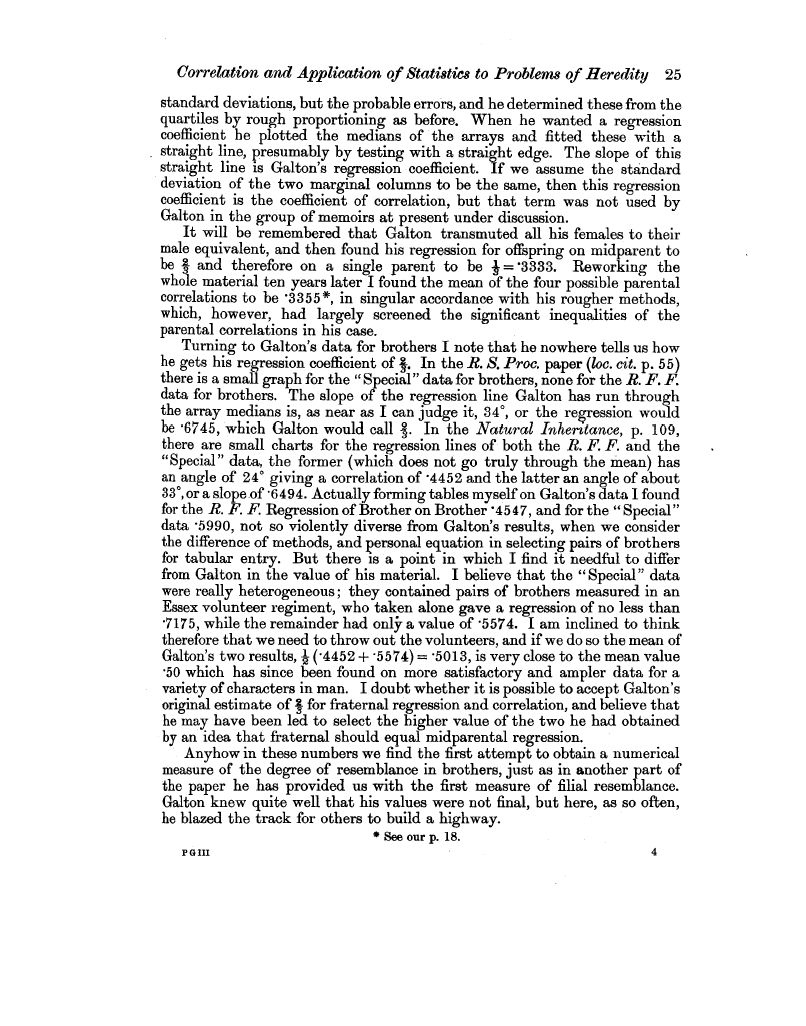| ||||||

OCR Rendition - approximate
Correlation and Application of Statistics to Problems of Heredity 25 standard deviations, but the probable errors, and he determined these from the quartiles by rough proportioning as before. When he wanted a regression coefficient he plotted the medians of the arrays and fitted these with a straight line, presumably by testing with a straight edge. The slope of this straight line is Galton's regression coefficient. If we assume the standard deviation of the two marginal columns to be the same, then this regression coefficient is the coefficient of correlation, but that term was not used by Galton in the group of memoirs at present under discussion. It will be remembered that Galton transmuted all his females to their male equivalent, and then found his regression for offspring on midparent to be 3 and therefore on a single parent to be 2='3333. Reworking the whole material ten years later I found the mean of the four possible parental correlations to be '3355*, in singular accordance with his rougher methods, which, however, had largely screened the significant inequalities of the parental correlations in his case. Turning to Galton's data for brothers I note that he nowhere tells us how he gets his regression coefficient of 2. In the R. S. Proc. paper (loc. cit. p. 55) there is a small graph for the " Special" data for brothers, none for the R. F. F. data for brothers. The slope of the regression line Galton has run through the array medians is, as near as I can judge it, 34°, or the regression would be •6745, which Galton would call 3. In the Natural Inheritance, p. 109, there are small charts for the regression lines of both the R. F. F. and the "Special" data, the former (which does not go truly through the mean) has an angle of 24° giving a correlation of '4452 and the latter an angle of about 33°, or a slopee of •6494. Actually forming tables myself on Galton's data I found for the R. F. F. Regression of Brother on Brother '4547, and for the "Special" data •5990, not so violently diverse from Galton's results, when we consider the difference of methods, and personal equation in selecting pairs of brothers for tabular entry. But there is a point in which I find it needful to differ from Galton in the value of his material. I believe that the "Special" data were really heterogeneous; they contained pairs of brothers measured in an Essex volunteer regiment, who taken alone gave a regression of no less than '7175, while the remainder had only a value of •5574. I am inclined to think therefore that we need to throw out the volunteers, and if we do so the mean of Galton's two results, 2(-4452+ '5574) = •5013, is very close to the mean value 50 which has since been found on more satisfactory and ampler data for a variety of characters in man. I doubt whether it is possible to accept Galton's original estimate of s for fraternal regression and correlation, and believe that he may have been led to select the higher value of the two he had obtained by an idea that fraternal should equal midparental regression. Anyhow in these numbers we find the first attempt to obtain a numerical measure of the degree of resemblance in brothers, just as in another part of the paper he has provided us with the first measure of filial resemblance. Galton knew quite well that his values were not final, but here, as so often, he blazed the track for others to build a highway. * See our p. 18. P G III 4
|